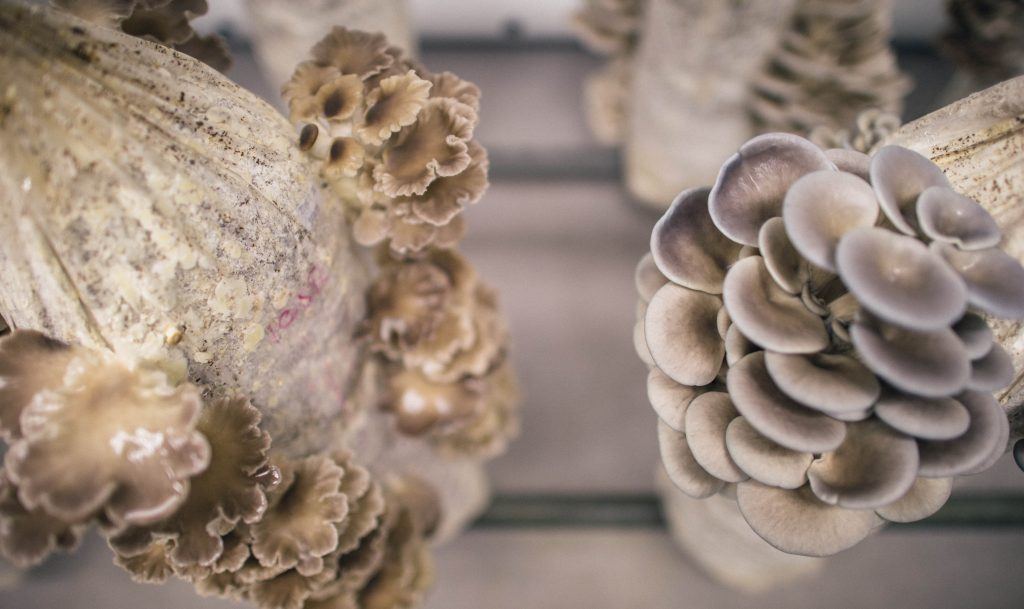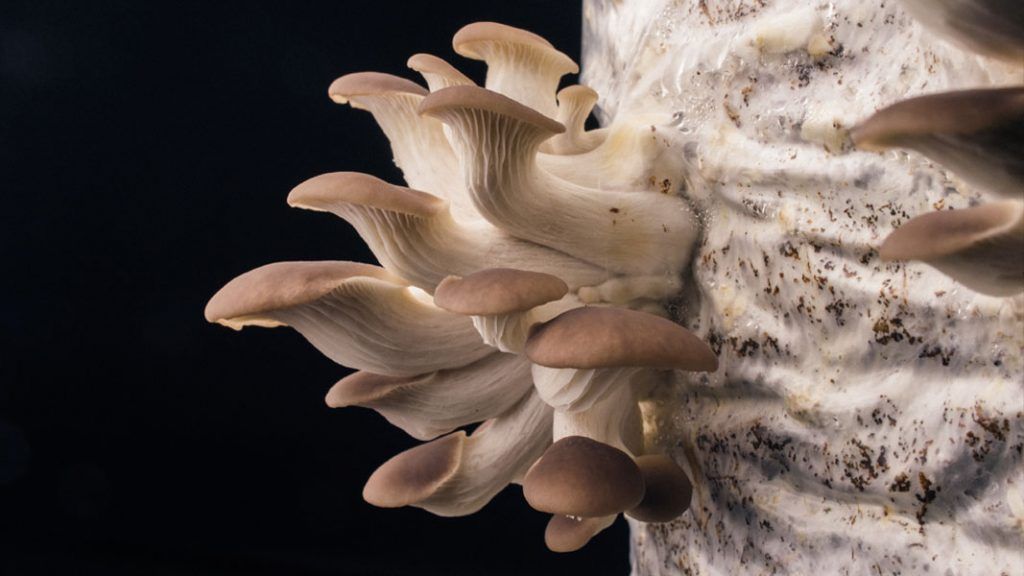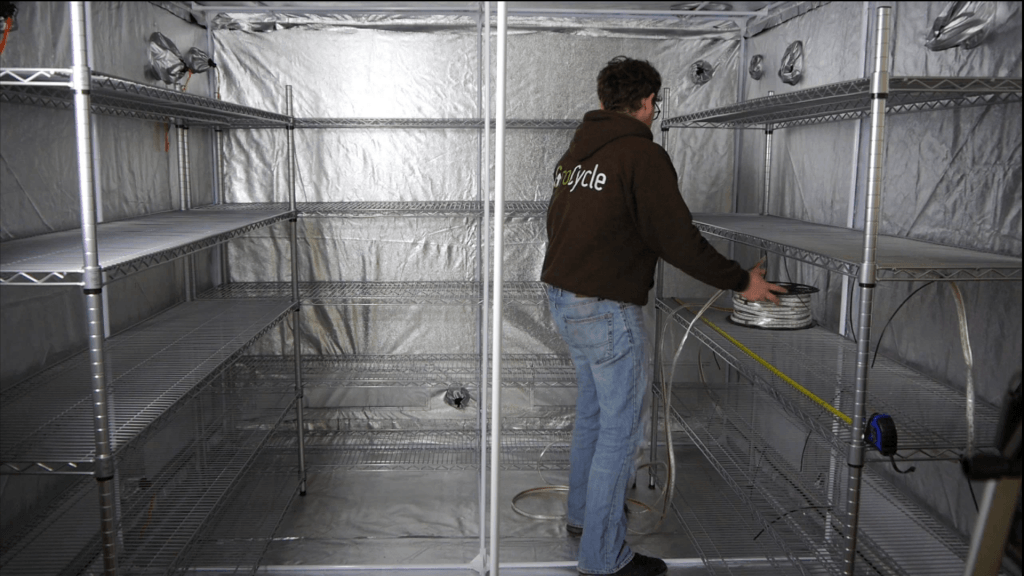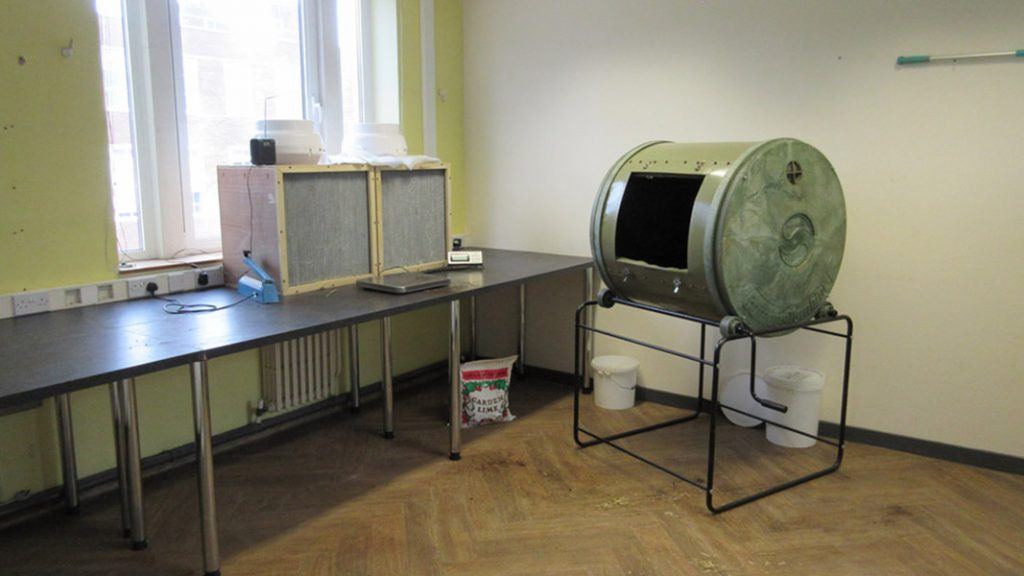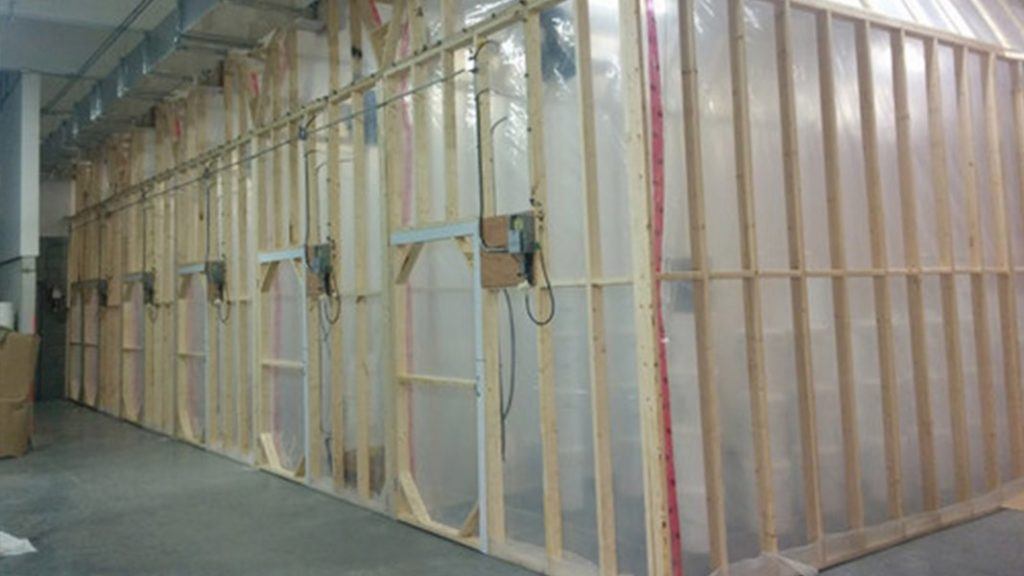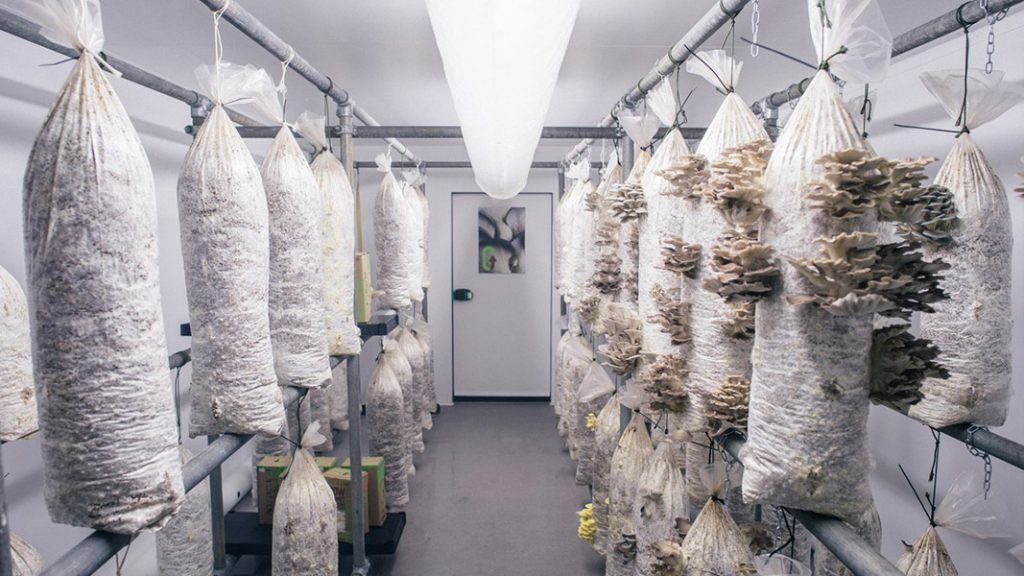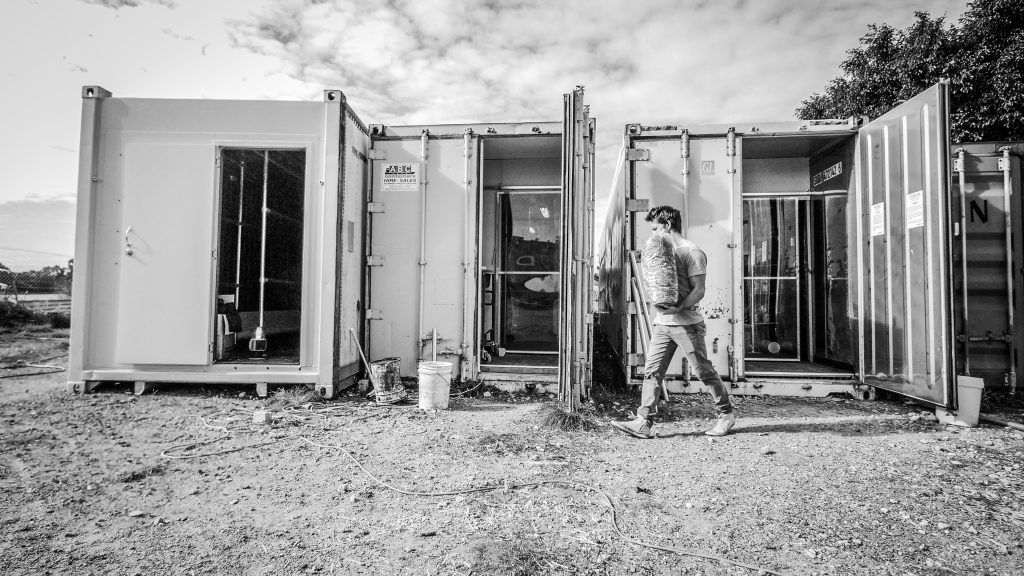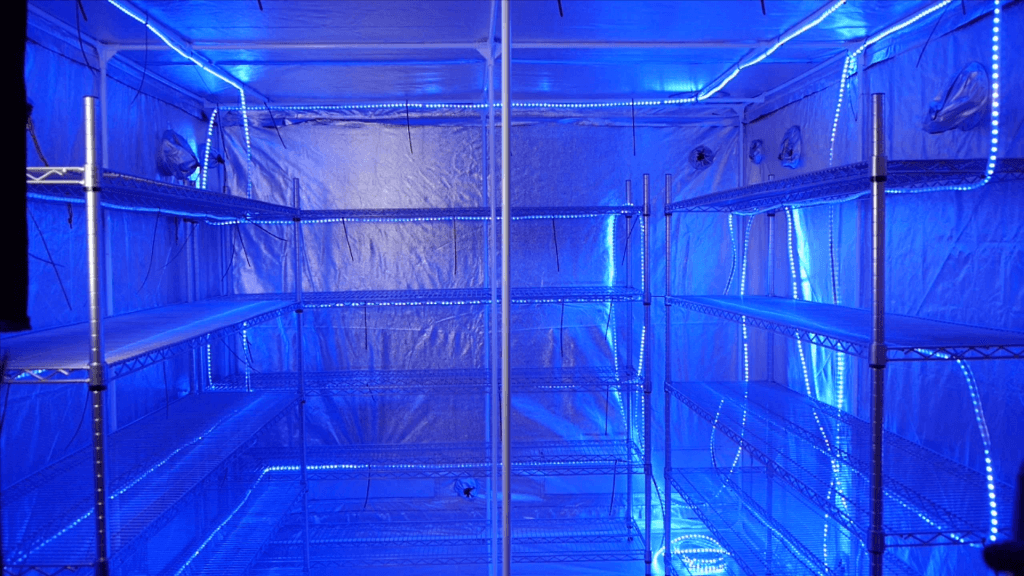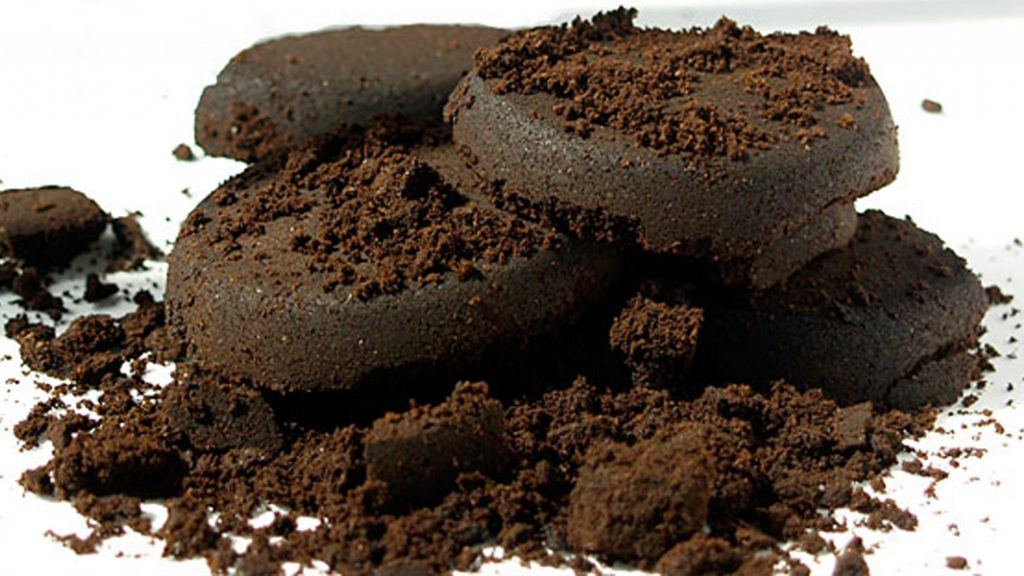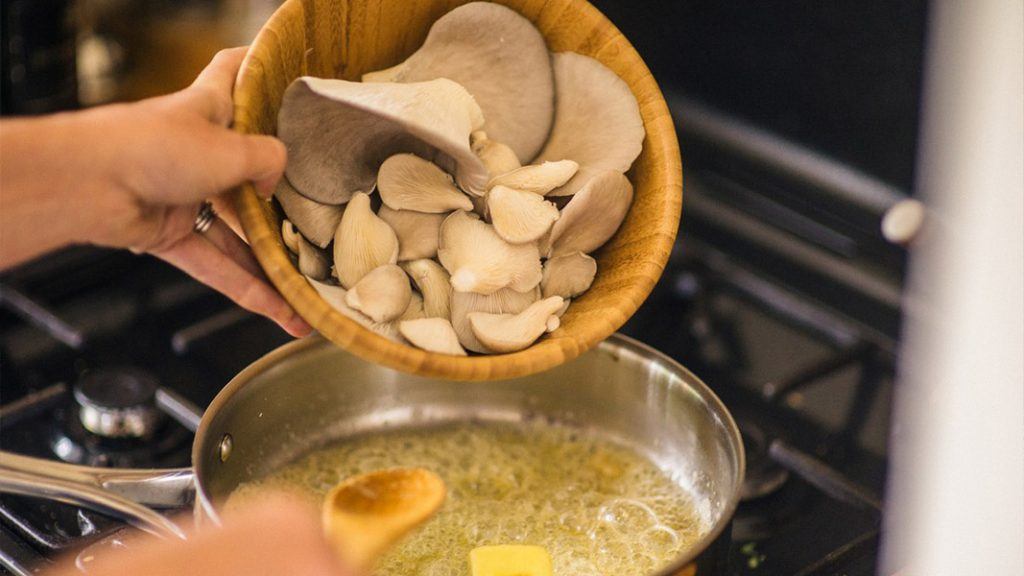Here’s a quick run down of what we’ll cover in this article:
- Why Mushrooms are a great crop to grow
- Why they’re perfect for small-scale local food production
- How many mushrooms can be grown in a small unused space
- Why low-tech mushroom farming is the easiest method
- Some ideas for generating income from mushrooms
Ok, if that sounds like something you want to learn more about, let’s get stuck in!:
...Short of time?
You can also download this article as a free ebook
Small Scale Food Growing
Imagine being able to grow lots of high-value local food, in an easy and reliable way.
You don’t need access to land, and chances are that no one else in your area is already doing it.
You could make a part time income from it, or run it as a community food project.
Sounds impossible?
Then chances are you already know a bit about growing food on a small scale.
You probably already know that growing food can be a hard way to earn money and that it’s labour intensive.
Not just that – you probably also know that you need to grow a lot of produce, have good growing skills AND access to land.
But do you also know that you can grow a lot of high-value mushrooms in un-used spaces, and that it can be quite quick to learn?
If not, let me tell you a bit about it, and why I’m such a fan of growing them. I’ll also point you in the direction of how to get started if it interests you.
Learning how to grow mushrooms is more straightforward than you might think, read my complete guide of How To Grow Mushrooms.
Example of small scale mushroom growing
Note: this is just an example of one small scale setup’s weekly metrics.
You can obviously grow on a bigger or smaller scale than this too.
Grow Fast, Grow Anywhere
Oysters mushrooms, ready to harvest just 7 days after starting to grow out of the bag
Gourmet mushroom varieties like Oyster and Shiitake fetch a high price and are actually relatively simple to grow.
When I set out learning how to grow them back in 2008 with just a book to learn from, it took around a year for me to get reliable results, but I’ve since taught many people who have learnt in a matter of hours.
The way they’re grown under easily controlled conditions makes them very reliable and consistent once you’ve got the hang of it.
And wow, do they grow fast!
Oysters (the easiest variety to learn) can grow in just 3-4 weeks from start to finish – and you can grow a crop like this every week of the year.
You can also grow a lot in a small space, but more about that in a minute.
Take a look inside our low tech mushroom farm in this short video tour of our growing set up:
Local Mushrooms Rule!
The thing about small-scale local mushroom growing is that your mushrooms will be so much better than what’s likely to already be available in your local area.
Mushrooms are normally grown in huge factory-like farms and travel long distances to reach the end consumer.
And being the fresh and fragile things that they are, they don’t travel well.
If you take a tray of beautiful freshly harvested mushrooms to the best restaurants, farmers markets and food outlets in your local area, you’re likely to see them snapped up pretty fast.
3 different varieties of Oyster mushrooms being trimmed ready for sale
How To Start Your Own Mini Mushroom Farm In 5 Steps
I’d love to see more small scale mushrooms farmers out there bringing top quality mushrooms to their local area.
But I’m aware it can feel a bit overwhelming with lots to learn.
To help, I’ve written an overview of the 5 main steps you’d need to take and some useful tips to get started:
1) Find some space
Most indoor spaces can be adapted for use, but maybe the best way to approach this is by asking what kind of space do mushrooms need to grow?
The 3 Main Stages Of The Mushroom Growing Cycle
There are 3 main stages to the growing process, each requiring a different space:
- Stage 1: Mixing & Inoculation – where the substrate ingredients & mushroom spawn are mixed and bagged (more on this process in a minute)
- Stage 2: Incubation – where the grow bags are left in a warm dark space for the spawn to grow throughout the bag
- Stage 3: Fruiting – where the colonised bag is exposed to fresh air, humidity and a little light which causes the mushrooms to ‘fruit’.
Stages 1 & 2 can be done in lots of different spaces and just require some basic equipment such as a compost tumbler, workbench, shelving and a few conditions like being able to clean easily and, in the case of the incubation space, to be easily kept at around 20-24C.
Out of the different stages, stage 3 is the trickiest to create, but certainly possible for most people to create for less than $1000.
I’ve built a few different fruiting room designs over the years, but our most recent one is the cheapest and simplest, built inside a hydroponics grow tent like this one.
Our cheapest and simplest fruiting room being built.
That grow room only took 2 days to set up and cost under $1500 (the shelves were a 3rd of the cost – it could be cheaper with existing or lower cost shelving).
The size of the space you need depends on lots of factors like how many mushrooms you’re aiming to grow, how you build your fruiting room and what options you have available to you.
As a guide though, if you optimised everything well, you’d be able to grow up to 50kg of mushrooms a week in a space of around 30m2, and this includes all of the 3 spaces mentioned above.
You may not want to grow this many if you’re working on your own though, as it’s a lot of work.
As a guideline, it’ll take you around 10-15 hours/week to grow 10kg mushrooms on a regular weekly cycle.
The essentials are really just access to water and electric, and being able to add a simple ducting installation bringing air in and out of the growing space.
There are loads of unused spaces out there, and often you can get them for low rent or even free.
We were given free use of a 125m2 space in an office building right in the middle of a city centre, which is where the UK’s first Urban Mushroom farm is based.
You could also use spare space in garages, basements, barns, shipping containers – someone we know is even looking at setting up in an old disused toilet block!
No kidding, she’s thinking that the disabled room would make a perfect mixing room, the gents a great incubation room, and the ladies an ideal spot for the mushrooms to fruit – pure genius!
2) Decide on your design
Once you’ve got an idea of where you might base your mini mushroom farm, you can start to imagine what your farm might look like – it’s time for a design.
There are so many different ways of designing your setup depending on the space you have and your budget, but I’ll show you some examples to help give you the general idea.
Mixing & Inoculation
Our mixing & inoculation room. Nice and simple – just a compost tumbler and workbench (we don’t even use the Hepa air filters these days)
The mixing and incubation rooms are simple and can be created easily in lots of different types of spaces.
Above, is our mixing room at GroCycle Urban Mushroom Farm. The key aspects are just a mixing vessel for the substrate, a workbench and the ability to clean the area down easily.
Incubation
The first incubation room I built, inside a shipping container
Yep, just shelving in an insulated room! This works well for smaller bags, as are often used for Shiitake or small scale Oyster production.
You can also use hanging rails instead, like the image below, if you’re growing Oyster mushrooms in bigger column bags:
Oyster mushroom mycelium growing on coffee grounds in 12Kg hanging column bags
Depending on where you’re based you may need a heating or cooling system in place to keep the temperature around 20 – 24C, so having an insulated space will keep energy usage to a minimum.
Fruiting
There are so many different ways to go about creating your fruiting room – here’s a few ways it can be done:
- DIY wood frame with plastic sheeting
Wooden stud frame with plastic sheeting, Blanc de Gris Mushroom Farm in Montreal
- Walk in fridge unit
Insulated fridge panel room – providing a well insulated and sealed space, GroCycle Urban Mushroom Farm
- Shipping container
Ex-refridgeration shipping containers converted into growing rooms, LifeCykel – a project in Australia that we helped to get set up
- Hydroponics tent
Our most recent fruiting room – The Mini Mushroom Farm, built inside a hydroponics tent.
There’s ups and down to each of these options, and it’s difficult for me to say which one would be best for you, as it depends on your space and budget.
If you join our free email course (below) you’ll get to learn more about why we think the hydroponics tent is a great option for most people just getting started.
3)Build your farm
Once you’ve decided on your design, it’s time to roll up your sleeves and build it.
There’s a lot of detail for this stage – way too much to cover in any useful way in this article – but it’s totally do-able for most people, regardless of your skills.
Eric (who I run GroCycle with), and I are pretty basic at DIY, yet we built this little 5m2 fruiting room quickly and easily in a couple of days.
Check out this short timelapse showing the first afternoon we spent on it:
When we built our bigger Urban Mushroom Farm setup, we did some of the work ourselves and simply asked a friend who was a builder/carpenter to help with the rest.
The point is, if you want to do it, you can make it happen. It’s not rocket science, and it can also be done on a budget to begin with and improved over time if you’re short of funds.
4)Start Growing (The Low Tech Way)
Let’s imagine for a moment that you’ve now created the spaces for your mini mushroom farm and are ready to get growing.
There are different ways of going about growing mushrooms, but I believe that the best way when growing on a small scale is the “Low-Tech” way.
Low-tech mushroom growing is a method we’ve been working on over the last few years which doesn’t require the large, expensive and energy-intensive equipment normally used in commercial mushroom growing.
Normally the substrate ingredients (often straw or sawdust) are heated to high temperatures in order to pasteurise them and kill off any competitor organisms.
Low-tech methods bypass this step or find low energy ways to achieve the same outcome.
For example we grow Oyster mushrooms on coffee grounds (already pasteurised from the brewing process), sawdust pellets (already pasteurised from the heat created during their production), or straw (easily pasteurised by soaking in a high pH cold water bath).
Waste coffee grounds – a plentiful (and already pasteurised) resource
Other features of the low-tech approach involve using fast growing, aggressive strains, and by using higher spawn rates than are normally used in large mushroom farms.
If you are looking for a low-tech ways of growing mushrooms, read my guides:
- How To Grow Mushrooms Outdoors With A Mushroom Bed.
- How to Grow Your Own DIY Mushrooms Spawn.
- The Ultimate Guide to Growing Mushrooms in Buckets
To give you an idea of how simple it can be, here’s a free video teaching you how to grow mushrooms on coffee grounds on a very small scale:
HOW TO GROW OYSTER MUSHROOMS ON COFFEE GROUNDS
- Clean work surface & mixing container
- Weigh out all materials before mixing
- Mix thoroughly, breaking up and pucks of coffee as you go
- Fill grow bags & seal
- Incubate in warm (20-24C) dark space for 2-3 weeks
- Cut holes & place bags in autumn-like conditions (humid, fresh air)
- Harvest mushrooms 1-2 weeks later.
Example mix shown in this video:
- 3kg fresh coffee grounds
- 600g pasteurised straw
- 300g Oyster mushroom spawn
Oyster mushrooms are by far the easiest to get started with, and can be grown reliably with high yields using low-tech methods.
For more info on growing Oyster mushrooms, check out our in-depth step by step guide to growing Oyster mushrooms here.
Over the last couple of years we’ve been trialling other varieties using the low-tech approach as well.
Most other gourmet varieties so far have produced mixed results, but through lots of experiments we’re now having reliable and good success with Shiitake mushrooms – one of the most highly prized gourmet varieties.
Shiitake mushrooms – grown using simple low-tech methods
I’m sure with more experimentation other varieties will be mastered soon as well.
The point here is that compared to traditional growing methods, this low-tech way of growing is much easier and cheaper for people to set-up and run successfully.
It’s also easier to learn. When I first started growing mushrooms I had to learn detailed laboratory techniques in order to get consistent results.
Now you can learn the basics in a few hours and be successfully growing right from the start.
You can also skip the learning curve of making your own substrate by buying in ready-to-fruit substrate bocks.
5) Harvesting & Selling Your mushrooms
Now picture your first bags have colonised well and after 2-3 weeks you put them in your new fruiting room.
You watch tiny mushroom pins appear and then grow, doubling in size every day, until they are magnificent mushrooms and ready for you to harvest.
You hear a crisp sound as you twist them off the bag……
You place them in a tray, alongside other perfectly formed mushrooms, and start thinking about who will get to enjoy them at their best.
Where To Sell Your Mushrooms
Here’s a few ideas of where you could sell them:
- Your local farmers market: farmers markets have become massive in recent years as people seek out high quality produce from small artisan producers. Take your mushrooms along and you’ll find plenty of interest.
- The best restaurants in your area: good chefs instantly recognise the high quality and taste of fresh mushrooms & are happy to pay for them – especially if they can advertise you as a local supplier on their menu.
- Your local veg box CSA scheme: having a diverse selection of locally grown crops really helps generates interest. Adding mushrooms will excite box customers & keep them happy through the leaner months.
- Nearby health or wholefoods stores: people who appreciate fresh & local food tend to either get a veg box or they shop for it at specialist food stores. Local mushrooms go down great in these stores too.
Oyster mushrooms, cooked within hours of harvest – coming to a restaurant near you?
Check out the sale price per kg for Oyster and Shiitake mushrooms in your country by seeing how much they’re sold for in any of the above places that you can find them in.
The price you can get will differ in each country.
In the UK for example, locally grown fresh Oyster mushrooms can sell for around £10 (US$13) per kg and Shiitake at £15 (US$19) per kg.
In Australia, Oysters fetch an impressive AU$ 40 (US$ 29) per kg!
You don’t want to try and compete with cheap imports, so you’re aiming to sell only to places that will appreciate (and pay) for the quality you offer.
Alongside the freshness and high quality of the mushrooms, you’ve got other selling points too: your mushrooms are locally grown using sustainable methods.
Lots of chefs, consumers, and retailers value these kinds of things and will support you by paying a premium price.
More income?
Of course, selling fresh mushrooms is not the only way you can make money from your efforts.
For anyone interested in turning it into more than a part time income, there are lots of other ways of generating extra income, whilst spreading the marvel of the mushroom world too.
Other ways to make money with mushrooms
- Mushroom growing kits: producing kits that help people to grow their own mushrooms at home can be a great source of extra income. They make unique gifts & can help spread the word about your business too.
- Workshops, tours & courses: once you’ve mastered the growing process, you can run courses and short workshops teaching people what you do and why mushrooms are fantastic!
- Street food/festival stall: take your mushrooms to a weekly food market or to festivals and cook them up in all sorts of delicous ways to add extra value. All sorts of people who love mushrooms will love your stall!
- Mushroom based snacks: you can add extra value by turning some of your crop into mushroom burgers, tempura or crouquettes – perfect healthy veggie snacks.
- Partnership with social enterprises/charities working with disadvantaged groups: growing mushrooms is a great activity to get stuck in and use your hands, as well as learning a wide range of other skills. Link up with an organisation working with ex-prisoners for example and get funding to help teach them to grow mushrooms!
Running workshops is a great way to get people involved & make a bit of income too.
Next Steps….
So, hopefully this article has helped you to see why mushroom cultivation has been gaining in popularity over the last few years.
It’s not difficult or expensive to set-up on a small scale, which is why I believe lots of small mushrooms farms will pop up everywhere in the next few years.
The question is – do you want to get involved?
Do you want to be a small-scale local food grower or run a social enterprise growing food for your local community?
If so, leave your email below to take your next steps.
We’ll send you a mini tour of our latest fruiting room, The Mini Mushroom Farm, as well as a series of emails to teach you more.
Let’s not keep imagining – it’s time for action.
See you soon.
Adam Sayner, GroCycle
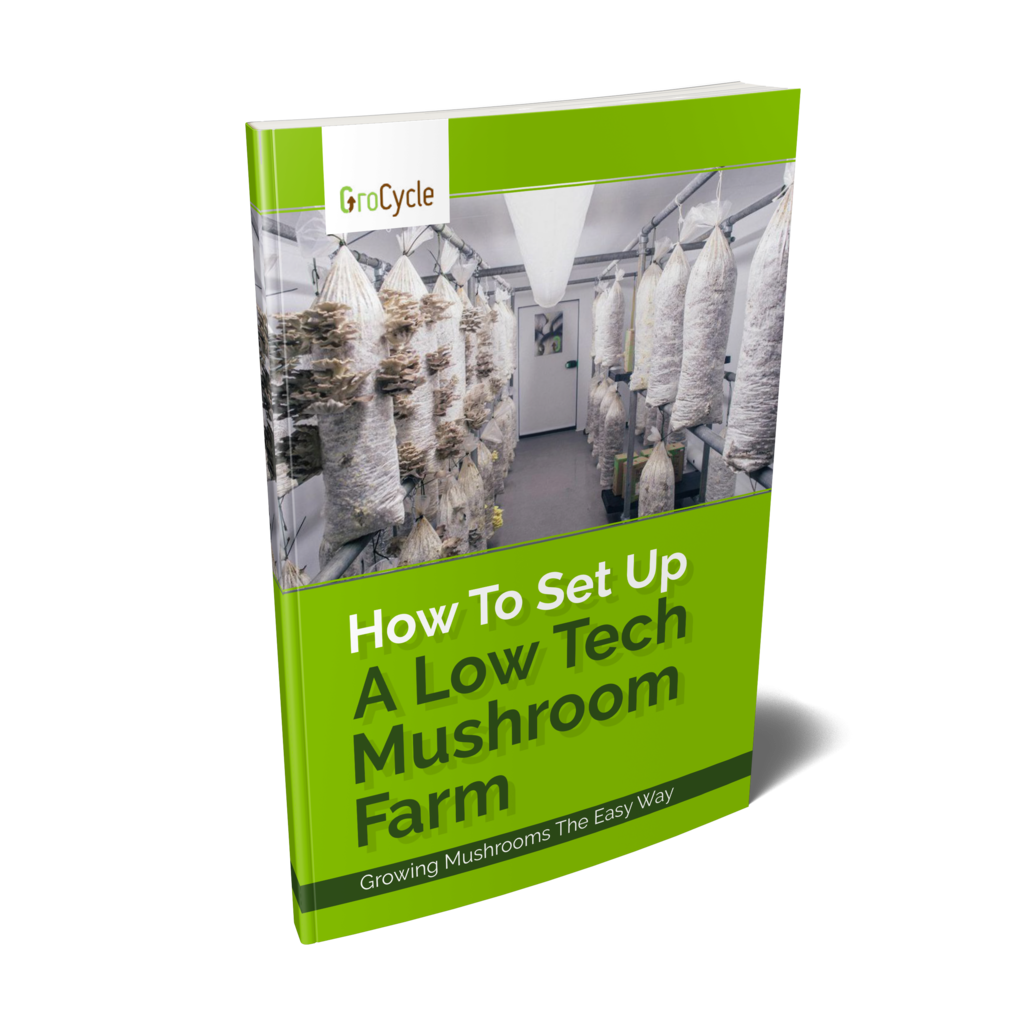
This FREE Guide Includes
- How to grow mushrooms without loads of expensive equipment
- Why you don’t needs lots of space to grow mushrooms
- 5 different ways to build a fruiting chamber
- How to run a mushroom farm
- Can you make a living out of this?

Are you interested in learning how to grow mushrooms?

